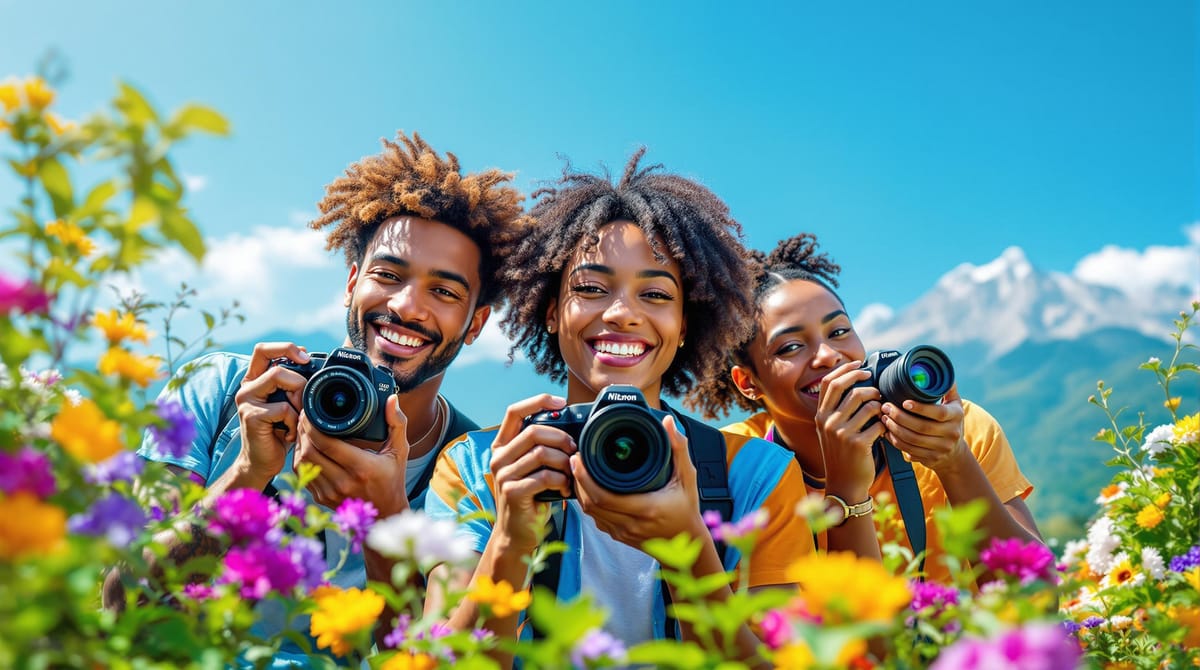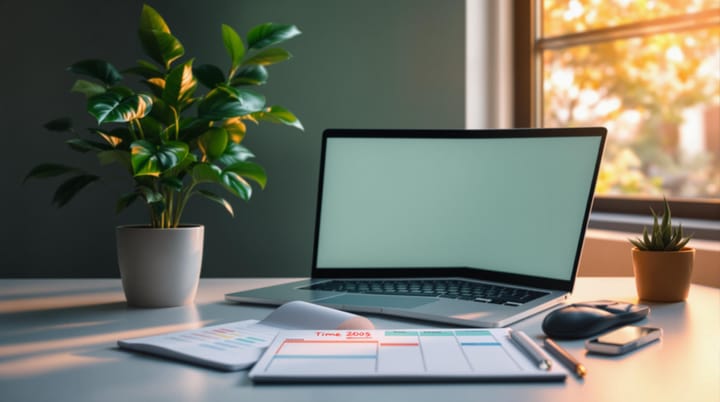Photography Basics: Essential Tips for Beginners
Learn essential photography tips for beginners, covering exposure, composition, lighting, and gear to elevate your skills and confidence.

Photography is for everyone, whether you're a hobbyist or aiming for a career. Start with these basics:
- Master the Exposure Triangle: Learn how aperture, shutter speed, and ISO work together to control light and create effects.
- Understand Camera Modes: Move beyond auto settings to modes like Aperture Priority (Av) or Manual (M) for more control.
- Focus on Composition: Use the Rule of Thirds, leading lines, and framing to make your photos visually appealing.
- Work with Light: Use natural light during golden hour or experiment with artificial lighting for indoor shots.
- Choose the Right Gear: Start with an entry-level DSLR or mirrorless camera, a versatile lens like the 50mm f/1.8, and basic accessories like a tripod.
Photography isn’t about having the best gear - it’s about practice, experimenting with techniques, and developing your style. Dive in, and start creating images that tell your story.
Master the Exposure Triangle in 15 Minutes
Understanding Your Camera
Getting familiar with your camera's main functions is the first step to taking control of your photography. Here's a breakdown of the key elements that will help you move beyond automatic settings and start shooting with purpose.
The Exposure Triangle: Aperture, Shutter Speed, ISO
The exposure triangle consists of three settings - aperture, shutter speed, and ISO - that determine how light is captured in your photos:
- Aperture (f-numbers): Controls how much light enters the lens and affects depth of field (how much of the image is in focus).
- Shutter Speed: Dictates how long the sensor is exposed to light, allowing you to freeze or blur motion.
- ISO: Adjusts the camera's sensitivity to light, balancing brightness and image noise.
Understanding how these settings interact lets you control light and experiment with creative effects. Try adjusting one setting at a time to see how it changes your photos.
Camera Modes: Auto, Aperture Priority, Shutter Priority, Manual
Cameras come with various modes to help you achieve the right exposure for different situations:
| Mode | Ideal For | What You Control |
|---|---|---|
| Auto | Quick, casual shots | Fully automated |
| Aperture Priority (Av/A) | Portraits, landscapes | Aperture only |
| Shutter Priority (Tv/S) | Sports, action shots | Shutter speed only |
| Manual (M) | Full creative control | All settings |
"Understanding the purpose and value of exposure is a must for photographers, particularly beginners who are serious about developing their craft." – Viktor Elizarov, Travel Photographer
Camera Basics: Focus, Zoom, White Balance
Modern cameras come with features that make focusing and color adjustments easier:
- Focus Modes: Use AF-S for still subjects, AF-C for moving ones, and AF-A for mixed scenarios.
- White Balance: Auto White Balance works well in most cases, but manual adjustments can improve color accuracy in tricky lighting, like indoors or under mixed light sources.
- Metering Modes: These help your camera measure light. Use Matrix for general shots, Center-weighted for portraits, and Spot for focusing on small areas.
Mastering these controls takes time, so focus on one feature at a time. As you gain confidence, you'll be able to combine these settings to create the images you envision. Once you're comfortable with your camera's functions, you can shift your attention to composition techniques for more striking photos.
Composition Techniques
Once your camera settings are ready, it's time to focus on composition - the art of arranging elements in your frame to create visually appealing photos.
The Rule of Thirds
The Rule of Thirds is a simple yet powerful guideline. By dividing the frame into nine equal parts using a 3x3 grid (available in most cameras), you can create balanced and engaging images. Place key elements along the grid lines or at their intersections, rather than in the center. For landscapes, align the horizon with either the top or bottom horizontal line. When shooting portraits, position your subject's eyes along the upper third line or at an intersection point.
"If you are tuned in to the imagery we see around us, I feel like you sort of absorb [the rule of thirds] even if you can't put your finger on it." - Khara Plicanic, Photographer, Author, and Instructor [1]
Leading Lines and Framing
Leading lines, such as roads, rivers, or railway tracks, naturally guide the viewer's eye to the main subject. Similarly, natural frames - like archways or tree branches - add depth and context to your shots.
| Type of Line | Common Examples | Purpose |
|---|---|---|
| Horizontal | Horizons, beaches | Evoking calm and stability |
| Vertical | Buildings, trees | Conveying power and height |
| Diagonal | Roads, rivers | Suggesting movement and energy |
| Converging | Railway tracks, paths | Directing focus to a specific point |
To use leading lines effectively, adjust your position so that these elements direct attention toward your subject.
Balancing Elements
Balancing elements in your frame helps your subject stand out while maintaining harmony. Pay attention to visual weight - large objects, bright colors, or intricate patterns tend to draw the eye. Counterbalance dominant elements with smaller or less prominent ones on the opposite side of the frame.
"The goal of a strong composition is usually to do one or two things. First, it should make it clear what the subject or focus of the image is." - Fstoppers [1]
Once you've nailed composition, learning how to work with light will take your photography to the next level.
Lighting for Better Photos
Light is the backbone of photography, and learning how to use it effectively can take your images to the next level. It’s not just about technical precision - light also sets the mood and tells a story in your photos.
Using Natural Light
Natural light is a powerful tool, especially for beginners. The golden hour - shortly after sunrise or before sunset - offers soft, warm light that's ideal for creating stunning images. Position your subject to face the light for even tones or use side lighting to add depth and texture.
| Time of Day | Light Quality | Best For |
|---|---|---|
| Golden Hour | Soft, warm, directional | Portraits, landscapes |
| Midday | Harsh, direct | Urban photography, architecture |
| Overcast | Diffused, even | Product shots, nature |
Want a quick tip for portraits? Place your subject near a large window. The filtered natural light creates soft, flattering effects without needing extra equipment.
Artificial Lighting Basics
Indoor photography often calls for artificial lighting. Start simple: use one light source, like a flash or studio light, and experiment with its position. A softbox is a great addition - it spreads light evenly, giving a natural look.
Here’s a rule of thumb: the closer the light, the brighter and harsher the shadows. Move it farther away for softer, dimmer light. Begin with basic setups and add complexity as you grow more comfortable.
Adjusting White Balance
Light sources have different color temperatures, which can affect how colors appear in your photos. Use your camera’s white balance settings to get accurate colors.
| Light Source | White Balance Setting | Color Temperature |
|---|---|---|
| Daylight | Daylight/5500K | Neutral, natural |
| Indoor Lighting | Tungsten/3200K | Warm, yellow |
| Fluorescent | Fluorescent/4000K | Cool, greenish |
For precise results, photograph a white or gray card under your lighting conditions and use the custom white balance feature. Shooting in RAW? You can fine-tune white balance during post-processing. In mixed lighting, match the setting to the dominant light source for consistency.
Lighting isn’t just about technical perfection - it’s a creative tool. Play around with different techniques to find your style and set the mood you want. Once you’re comfortable with lighting, you can explore equipment options to further refine your photography.
Choosing Beginner Photography Equipment
Picking between DSLR and mirrorless cameras is one of the first big decisions for photography beginners. Both types come with their own perks and can fit into a beginner’s budget.
DSLR vs Mirrorless Cameras
| Feature | DSLR | Mirrorless |
|---|---|---|
| Battery Life | 1,550+ shots per charge | Shorter battery life |
| Size & Weight | Larger, heavier | Compact, lightweight |
| Lens Options | Wide variety, affordable | Expanding, newer technology |
| Autofocus | Phase-detection (fast for stills) | Advanced tracking for motion |
| Price Range | $300-750 (entry-level) | $600-1,200 (entry-level) |
If you're on a budget, the Nikon D3500 is a solid choice, costing about $350 with an 18-55mm kit lens. For those leaning toward mirrorless, the Olympus OM-D E-M10 Mark IV is a great option. It’s compact, easy to handle, and comes with excellent image stabilization.
Lenses for Beginners
When starting out, go for lenses that let you explore different photography styles. The 50mm f/1.8, often called the "nifty fifty", is a fantastic first lens. It’s priced under $200 for both Canon and Nikon and works wonders in low light or for portraits.
If your camera comes with a kit lens, the standard 18-55mm range is versatile enough for most everyday shots.
| Photography Type | Recommended Lens | Typical Price Range |
|---|---|---|
| Portrait | 50mm f/1.8 | $125-200 |
| Landscape | 18-55mm kit lens | Included with camera |
| Sports/Wildlife | 55-200mm f/4.5-6.3 | $200-350 |
Affordable Photography Accessories
You don’t need to spend a fortune on accessories to improve your photography. A tripod is essential for steady shots, especially in low light, while an external flash can greatly enhance indoor photos.
The Manfrotto BeFree tripod is lightweight and portable, perfect for landscapes or long exposures. For lighting, the Neewer TT560 flash offers solid performance at a budget-friendly price.
"An entry-level DSLR is still the best way to get high-quality imagery for a rock-bottom price." - Photography Life [1]
Pairing a good lens with the right lighting can make a noticeable difference in your photos. With a few essential tools, you’ll be ready to practice, improve, and build your confidence as a photographer.
Gaining Confidence as a Beginner Photographer
You've covered the basics - now it's time to boost your confidence through practice and exploration. Becoming skilled in photography takes commitment, regular effort, and a willingness to embrace the learning curve.
It's not about owning the priciest camera or memorizing every technical term. What matters most is action. Set aside just 20 minutes each week to focus on practicing one technique. Consistency is what helps you grow.
Confidence grows over time as you put in the effort and learn from your mistakes. Start with subjects and locations you know well, and gradually push yourself as your abilities improve. Use your understanding of camera settings in real-life scenarios. Play around with aperture, shutter speed, and ISO to see how they work together, helping you gain better control over exposure.
"Confidence isn't something you attain overnight – it is a skill in itself, a muscle that must be stretched and built up day after day."
Engage with photography communities to get feedback and discover new perspectives. Don't be afraid to try new things or make mistakes - they're part of the process. As you practice, you'll naturally develop your own style and artistic vision.
Every professional photographer started where you are now. By focusing on the basics and staying open to learning, you'll discover your ability to create photos that resonate. Let the journey inspire you, and let your creativity shape your growth as a photographer.




